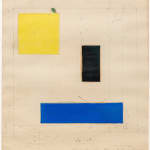

MARLOW MOSS British, 1889-1958
10 x 8 inches
Before display at the MuHKA, and subsequent arrival at Mayor Gallery in London, this work was kept in the suitcase, shown above, and featured in the 2022 film 'De Verdwenen Lijnen van Marlow Moss’ [The lost lines of Marlow Moss] directors: Fifi Visser and André van der Hout – featuring Andreas Oosthoek, Florette Dijkstra, Ankie de Jongh-Vermeulen, Bart De Baere, Yuranan Panya In, Matthijs Erdman, Joost Jobse, Maaike de Wolf-Mol and myself.
The scene captured on camera with Andreas Oosthoek and myself, at his kitchen table in the Nijhoff house at Groot Valkenisse in 2021, looking through the material and ephemera of the suitcase, was the first time I had seen these works in the flesh – this particular work is visible in the film.
This work, Untitled (yellow square, black and blue rectangles) with calculations, is clearly a preparatory drawing for a composition in development – although no known painting is an exact match, it is very close to the work on canvas White, Yellow and Black of 1953 (P/R57 in the catalogue in appendix to my 2008 PhD thesis).
White, Yellow and Black, 1953, was sold at Christie’s in Amsterdam in 2013 and was procured for display in the Moss shows I curated at Leeds Art Gallery in 2014, and Tate Britain in London 2015. The blue form has been excluded and the double-lines emphasised.
From A.H. Nijhoff’s account of Moss’s working method, published in the 1962 Stedelijk Museum exhibition catalogue (translated here from the Dutch) we learn the following:
A free-hand sketch in pencil on an odd sheet of paper or perhaps on a piece of linen, coloured in gouache or oils – that is the first stage of her paintings. Alterations are made to this sketch until she is satisfied with it. And only then does she start working with numbers and a ruler. The sketch is measured, ratios checked...
This work is perhaps a ‘second stage’ in the development of the composition, including as it does measurements and ruled lines. It is an extremely interesting work, of great value to scholars, as it lays bare Moss’s thought process and methodology – and includes the ‘double-lines' for which she is known.
-Lucy Howarth
Provenance
Nijhoff/ Oosthoek Collection, The NetherlandsExhibitions
Antwerp, Museum van Hedendaagse Kunst Antwerpen, Archiefpresentatie: Marlow Moss, 3 Jun - 21 Aug 2022
London, The Mayor Gallery, Marlow Moss / Vera Molnár: New Angles, 4 Sep – 1 Oct 2024Literature
To be included in the provisional Catalogue Raisonné
Certificate available


